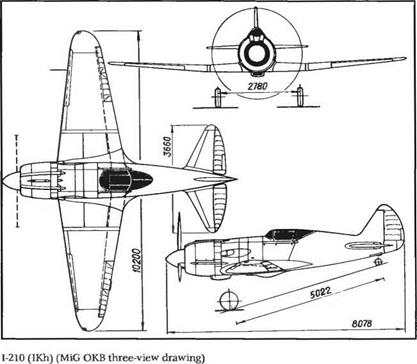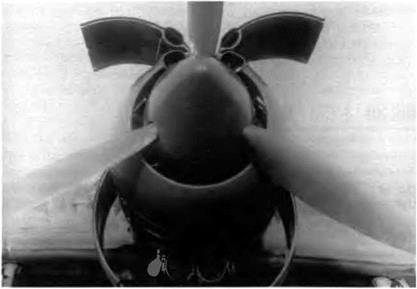MiG 3 with IV» 82 Engine /1210 / IKh
When series production of the MiG-3 stopped in December 1941 for lack of engines, the Perm power plant factory was producing the M – 82A, a 14-cylinder, double-row, air-cooled radial engine. Its power output was high at takeoff—1,251 kW (1,700 ch)—but it lost power rapidly with altitude. At 6,500 m (21,300 feet) its rating dropped to only 979 kW (1,330 ch)
Despite this shortcoming the MiG OKB redesigned the MiG-3 with an M-82 engine in a risky attempt to prolong the aircraft’s life. Chief engineer I. G. Lazarev tried to match the engine with the front fuselage structure with a minimum of modifications and designed an engine cowling to minimize load losses resulting from its internal turbulent flow.
The cockpit canopy was enlarged and deepened to improve rear and lateral visibility. The fin area was increased slightly to improve yaw stability, and the wing was fitted with leading-edge slats tested on a production MiG-3. The three 12.7-mm UBS machine guns (one on top of the engine cowling and one on each side of it) were controlled by a single trigger.
Five I-210s were completed in November-December 1941, and the first flight took place in December with Nil WS pilot V. Ye. Golofastov in the cockpit. From the very beginning of the test flights, strong vibrations occurred in the tail unit, and the aircraft’s maneuverability

|

proved to be rather scanty. The size of the engine master cross section and the poor airtightness of the engine cowling generated vortex flows that increased the drag significantly. Despite the high power of the M – 82, the maximum speed of the 1-210 was less than that of the MiG-3 with an AM-35A engine
The aircraft was tested in a TsAGI full-scale wind tunnel and returned to the OKB for modifications. The wind tunnel tests confirmed the decisive effect of the lack of cowling airtightness on the aircraft’s aerodynamic drag. They led at last to the design of a new aircraft code-named Ye and powered by a M-82F, which was not completed before the end of 1942. Despite its poor performance, the 1-210 was combat-proven on thb Kalinin front. Two 7.62-mm ShKAS synchronized machine guns were added to the basic armament.
In some OKB documents the 1-210 is referred to as the MiG-9 (the first of many).
Specifications
Span, 10.2 m (33 ft 5.6 in); length, 8.078 m (26 ft 6 in); wheel track, 2.78 m (9 ft 1.4 in); wheel base, 5.022 m (16 ft 5.7 in); wing area, 17.44 m2 (187.7 sq ft); empty weight, 2,720 kg (5,995 lb); takeoff weight, 3,382 kg (7,454 lb), fuel + oil, 360 kg (795 lb); wing loading, 193 9 kg/m2 (39.71 Ib/sq ft)
Performance
Max speed, 565 km/h at 6,150 m (305 kt at 20,170 ft); max speed at sea level, 475 km/h (257 kt); landing speed, 146 km/h (79 kt); climb to
5,0 m (16,400 ft) in 6.7 min; range, 1,070 km (665 mi); takeoff roll, 410 m (1,345 ft); landing roll, 535 m (1,755 ft).










